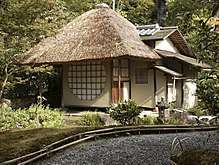Kōdai-ji
Kōdai-ji (高台寺, Kōdai-ji), formally identified as Jubuzan Kōdai-ji (鷲峰山高台寺, Jubuzan Kōdai-ji), is a temple of the Rinzai school of Zen Buddhism in Higashiyama-ku, Kyoto, Japan—the largest subtemple of the Kennin-ji branch.
| Kōdai-ji | |
|---|---|
高台寺 | |
.jpg) | |
| Religion | |
| Affiliation | Zen Buddhism |
| Sect | Rinzai |
| District | Higashiyama-ku |
| Prefecture | Kyoto Prefecture |
| Region | Kyoto |
| Location | |
| Location | Kyoto, Japan |
| Country | Japan |
 Shown within Japan | |
| Prefecture | Kyoto Prefecture |
| Geographic coordinates | |
| Architecture | |
| Founder | Kōdai-in |
| Funded by | Tokugawa Ieyasu |
| Date established | 1606 |
| Completed | 1606 |
History
.jpg)
It was established in 1606 by the nun Kōdai-in (often known by the title Kita no Mandokoro), who was the widow of Toyotomi Hideyoshi, to pray for her late husband. The principal image is a statue of Shaka.
The gardens of Kōdai-ji are a nationally designated Historic Site and Place of Scenic Beauty.[1]
The temple possesses a number of objects designated as Important Cultural Assets. Among these are the Main Gate and the Spirit Hall, noted for its use of maki-e. The temple is nicknamed the maki-e temple." It also holds paintings, including one of Hideyoshi, as well as textiles, and a bronze bell with an inscription dating it to 1606.

See also
- Glossary of Japanese Buddhism
- Ryozen Kannon, neighbouring shrine
References
- "高台寺庭園". Agency for Cultural Affairs. Retrieved 10 February 2012.
External links
| Wikimedia Commons has media related to Kodaiji. |
- Official English site
- 高台寺, official site (in Japanese and Chinese)
.jpg)